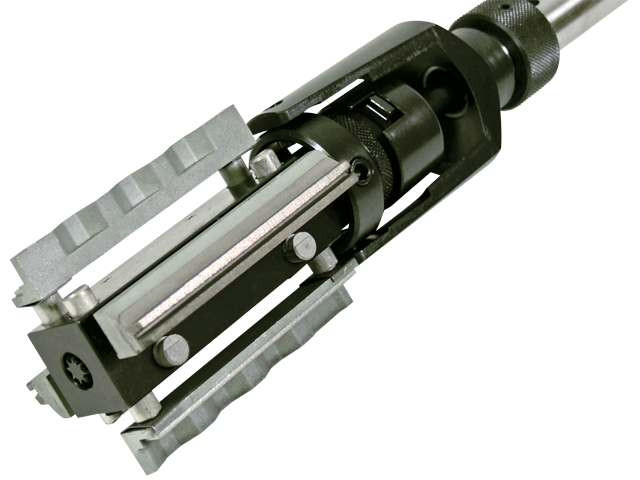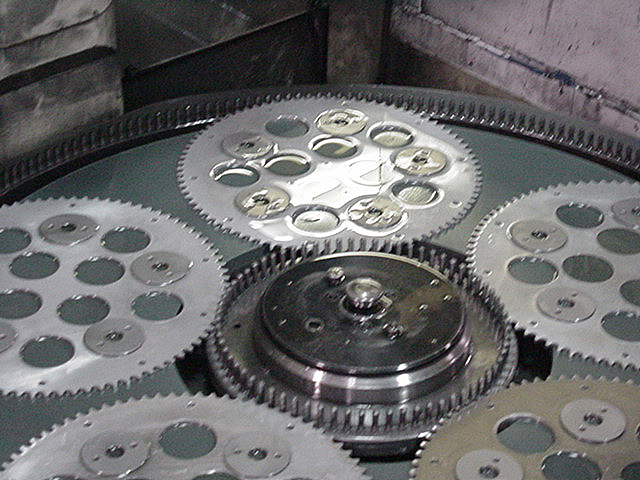Honing (metalworking) on:
[Wikipedia]
[Google]
[Amazon]
 Honing is an
Honing is an

 Honing uses a special tool, called a ''honing stone'' or a ''hone'', to achieve a precision surface. The hone is composed of abrasive grains that are bound together with an adhesive. Generally, honing grains are irregularly shaped and about 10 to 50 micrometers in diameter (300 to 1500 mesh grit). Smaller grain sizes produce a smoother surface on the workpiece.
A honing stone is similar to a grinding wheel in many ways, but honing stones are usually more
Honing uses a special tool, called a ''honing stone'' or a ''hone'', to achieve a precision surface. The hone is composed of abrasive grains that are bound together with an adhesive. Generally, honing grains are irregularly shaped and about 10 to 50 micrometers in diameter (300 to 1500 mesh grit). Smaller grain sizes produce a smoother surface on the workpiece.
A honing stone is similar to a grinding wheel in many ways, but honing stones are usually more
 *
*
 Honing is an
Honing is an abrasive machining
Abrasive machining is a machining process where material is removed from a workpiece using a multitude of small abrasive particles. Common examples include grinding, honing, and polishing. Abrasive processes are usually expensive, but capable of ti ...
process that produces a precision surface on a metal workpiece
A workpiece is a piece, often made of a single material, that is being processed into another desired shape (such as building blocks).
The workpiece is usually a piece of relatively rigid material such as wood, metal, plastic, or stone. After a ...
by scrubbing an abrasive
An abrasive is a material, often a mineral, that is used to shape or finish a workpiece through rubbing which leads to part of the workpiece being worn away by friction. While finishing a material often means polishing it to gain a smooth, reflec ...
grinding stone or grinding wheel
Grinding wheels contains abrasive compounds for grinding and abrasive machining operations. Such wheels are also used in grinding machines.
The wheels are generally made with composite material . This consists of coarse-particle aggregate press ...
against it along a controlled path. Honing is primarily used to improve the geometric form of a surface, but can also improve the surface finish
Surface finish, also known as surface texture or surface topography, is the nature of a surface as defined by the three characteristics of lay, surface roughness, and waviness.. It comprises the small, local deviations of a surface from the perf ...
.
Typical applications are the finishing of cylinders
A cylinder (from ) has traditionally been a three-dimensional solid, one of the most basic of curvilinear geometric shapes. In elementary geometry, it is considered a prism with a circle as its base.
A cylinder may also be defined as an infini ...
for internal combustion engines
An internal combustion engine (ICE or IC engine) is a heat engine in which the combustion of a fuel occurs with an oxidizer (usually air) in a combustion chamber that is an integral part of the working fluid flow circuit. In an internal combus ...
, air bearing
Air bearings (also known as aerostatic or aerodynamic bearings) are fluid bearings that use a thin film of pressurized gas to provide a low friction load-bearing interface between surfaces. The two surfaces do not touch, thus avoiding the tradit ...
spindle
Spindle may refer to:
Textiles and manufacturing
* Spindle (textiles), a straight spike to spin fibers into yarn
* Spindle (tool), a rotating axis of a machine tool
Biology
* Common spindle and other species of shrubs and trees in genus ''Euony ...
s and gear
A gear is a rotating circular machine part having cut teeth or, in the case of a cogwheel or gearwheel, inserted teeth (called ''cogs''), which mesh with another (compatible) toothed part to transmit (convert) torque and speed. The basic pr ...
s. There are many types of hones, but all consist of one or more abrasive stones that are held under pressure
Pressure (symbol: ''p'' or ''P'') is the force applied perpendicular to the surface of an object per unit area over which that force is distributed. Gauge pressure (also spelled ''gage'' pressure)The preferred spelling varies by country and e ...
against the surface they are working on.
Other similar processes are lapping
Lapping is a machining process in which two surfaces are rubbed together with an abrasive between them, by hand movement or using a machine.
Lapping often follows other subtractive processes with more aggressive material removal as a first step ...
and superfinishing Superfinishing, also known as micromachining, microfinishing, and short-stroke honing, is a metalworking process that improves surface finish and workpiece geometry. This is achieved by removing just the thin amorphous surface layer left by the la ...
.
Honing stones

 Honing uses a special tool, called a ''honing stone'' or a ''hone'', to achieve a precision surface. The hone is composed of abrasive grains that are bound together with an adhesive. Generally, honing grains are irregularly shaped and about 10 to 50 micrometers in diameter (300 to 1500 mesh grit). Smaller grain sizes produce a smoother surface on the workpiece.
A honing stone is similar to a grinding wheel in many ways, but honing stones are usually more
Honing uses a special tool, called a ''honing stone'' or a ''hone'', to achieve a precision surface. The hone is composed of abrasive grains that are bound together with an adhesive. Generally, honing grains are irregularly shaped and about 10 to 50 micrometers in diameter (300 to 1500 mesh grit). Smaller grain sizes produce a smoother surface on the workpiece.
A honing stone is similar to a grinding wheel in many ways, but honing stones are usually more friable
Friability ( ), the condition of being friable, describes the tendency of a solid substance to break into smaller pieces under duress or contact, especially by rubbing. The opposite of friable is indurate.
Substances that are designated hazardous, ...
, so that they conform to the shape of the workpiece as they wear in. To counteract their friability, honing stones may be treated with wax or sulfur to improve life; wax is usually preferred for environmental reasons.
Any abrasive material may be used to create a honing stone, but the most commonly used are corundum
Corundum is a crystalline form of aluminium oxide () typically containing traces of iron, titanium, vanadium and chromium. It is a rock-forming mineral. It is a naturally transparent material, but can have different colors depending on the pres ...
, silicon carbide
Silicon carbide (SiC), also known as carborundum (), is a hard chemical compound containing silicon and carbon. A semiconductor, it occurs in nature as the extremely rare mineral moissanite, but has been mass-produced as a powder and crystal sin ...
, cubic boron nitride
Boron nitride is a thermally and chemically resistant refractory compound of boron and nitrogen with the chemical formula BN. It exists in various crystalline forms that are isoelectronic to a similarly structured carbon lattice. The hexagonal ...
, and diamond
Diamond is a Allotropes of carbon, solid form of the element carbon with its atoms arranged in a crystal structure called diamond cubic. Another solid form of carbon known as graphite is the Chemical stability, chemically stable form of car ...
. The choice of abrasive material is usually driven by the characteristics of the workpiece material. In most cases, corundum or silicon carbide are acceptable, but extremely hard workpiece materials must be honed using superabrasives.
The hone is usually turned in the bore while being moved in and out. Special cutting fluid
Cutting fluid is a type of coolant and lubricant designed specifically for metalworking processes, such as machining and stamping. There are various kinds of cutting fluids, which include oils, oil-water emulsions, pastes, gels, aerosols (mists) ...
s are used to give a smooth cutting action and to remove the material that has been abraded. Machines can be portable, simple manual machines, or fully automatic with gauging depending on the application.
Modern advances in abrasives have made it possible to remove much larger amount of material than was previously possible. This has displaced grinding in many applications where "through machining" is possible. External hones perform the same function on shafts.
Process mechanics
Since honing stones look similar to grinding wheels, it is tempting to think of honing as a form of low-stock removalgrinding
Grind is the cross-sectional shape of a blade.
Grind, grinds, or grinding may also refer to:
Grinding action
* Grinding (abrasive cutting), a method of crafting
* Grinding (dance), suggestive club dancing
* Grinding (video gaming), repetitive and ...
. Instead, it is better to think of it as a self-truing grinding process.
In grinding, the wheel follows a simple path. For example, in plunge grinding a shaft, the wheel moves in towards the axis of the part, grinds it, and then moves back out. Since each slice of the wheel repeatedly contacts the same slice of the workpiece, any inaccuracies in the geometric shape of the grinding wheel will be transferred onto the part. Therefore, the accuracy of the finished workpiece geometry is limited to the accuracy of the truing dresser. The accuracy becomes even worse as the grind wheel wears, so truing must occur periodically to reshape it.
The limitation on geometric accuracy is overcome in honing because the honing stone follows a complex path. In bore honing, for example, the stone moves along two paths simultaneously. The stones are pressed radially outward to enlarge the hole while they simultaneously oscillate axially. Due to the oscillation, each slice of the honing stones touch a large area of the workpiece. Therefore, imperfections in the honing stone's profile cannot transfer to the bore. Instead, both the bore and the honing stones conform to the average shape of the honing stones' motion, which in the case of bore honing is a cylinder. This averaging effect occurs in all honing processes; both the workpiece and stones erode until they conform to the average shape of the stones' cutting surface. Since the honing stones tend to erode towards a desired geometric shape, there is no need to true them. As a result of the averaging effect, the accuracy of a honed component often exceeds the accuracy of the machine tool that created it.
The path of the stone is not the only difference between grinding and honing machines, they also differ in the stiffness of their construction. Honing machines are much more compliant than grinders. The purpose of grinding is to achieve a tight size tolerance. To do this, the grinding wheel must be moved to an exact position relative to the workpiece. Therefore, a grinding machine must be very stiff and its axes must move with very high precision.
A honing machine is relatively inaccurate and imperfect. Instead of relying on the accuracy of the machine tool, it relies on the averaging effect between the stone and the workpiece. Compliance is a requirement of a honing machine that is necessary for the averaging effect to occur. This leads to an obvious difference between the two machines: in a grinder the stone is rigidly attached to a slide, while in honing the stone is actuated with pneumatic or hydraulic pressure.
High-precision workpieces are usually ground and then honed. Grinding determines the size, and honing improves the shape.
The difference between honing and grinding is not always the same. Some grinders have complex movements and are self-truing, and some honing machines are equipped with in-process gauging for size control. Many through-feed grinding operations rely on the same averaging effect as honing.
Honing configurations
Bore honing
Bore or Bores often refer to:
*Boredom
* Drill
Relating to holes
* Boring (manufacturing), a machining process that enlarges a hole
** Bore (engine), the diameter of a cylinder in a piston engine or a steam locomotive
** Bore (wind instruments), ...
* Flat honing
Flat honing is a metalworking grinding process used to provide high quality flat surfaces. It combines the speed of grinding or honing with the precision of lapping. It has also been known under the terms high speed lapping and high precision g ...
* OD honing / Super Finish / Fine Finish (taper and straight)
* Spherical honing
* Track/raceway honing
Economics
Since honing is a high-precision process, it is also relatively expensive. Therefore, it is only used in components that demand the highest level of precision. It is typically the last manufacturing operation before the part is shipped to a customer. The dimensional size of the object is established by preceding operations, the last of which is usually grinding. Then the part is honed to improve a form characteristic such as surface finish, roundness, flatness, cylindricity, or sphericity.Performance advantages of honed surfaces
Since honing is a relatively expensive manufacturing process, it can only be economically justified for applications that require very good form accuracy. The improved shape after honing may result in a quieter running or higher-precision component. The flexible honing tool provides a relatively inexpensive honing process. This tool produces a controlled surface condition unobtainable by any other method. It involves finish, geometry and metallurgical structure. A high-percentage plateau free of cut, torn and folded metal is produced. The flexible hone is a resilient, flexible honing tool with a soft cutting action. The abrasive globules each have independent suspension that assures the tool to be self-centering, self-aligning to the bore, and self-compensating for wear.Cross-hatch finish
A "cross-hatch" pattern is used to retain oil or grease to ensure proper lubrication and ring seal of pistons in cylinders. A smooth glazed cylinder wall can cause piston ring and cylinder scuffing. The "cross-hatch" pattern is used on brake rotors and flywheels.Plateau finish
The plateau finish is one characterised by the removal of "peaks" in the metal while leaving the cross-hatch intact for oil retention. The plateaued finish increases the bearing area of the finish and does not require the piston or ring to "break in" the cylinder walls. Plateau honing specification: # Rz .... 3–6 micrometres, # Rpk.... ≤0.3 micrometres, # Rk..... 0.3–1.5 micrometres, # Rvk.... 0.8–2.0 micrometres.See also
*Single-pass bore finishing Single-pass bore finishing is a machining process similar to honing to finish a bore, except the tool only takes a single pass. The process was originally developed to improve bore quality in cast iron workpieces..
Process
This process uses multi ...
Notes
{{DEFAULTSORT:Honing (Metalworking) Grinding and lapping Machine tools